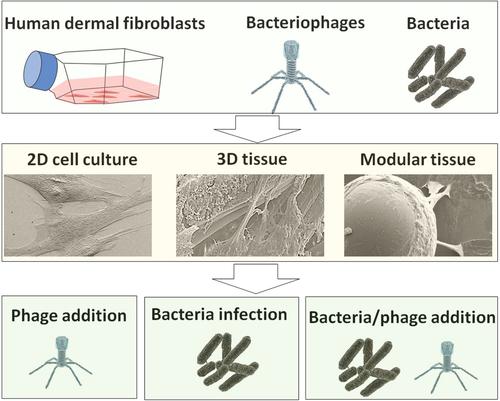当前位置:
X-MOL 学术
›
Biotechnol. Bioeng.
›
论文详情
Our official English website, www.x-mol.net, welcomes your feedback! (Note: you will need to create a separate account there.)
Evaluation of bacteriophages for the alleviation of potential bacterial contamination risks in developmental engineering
Biotechnology and Bioengineering ( IF 3.5 ) Pub Date : 2024-06-22 , DOI: 10.1002/bit.28778 Yu Xiang 1 , Xujin Bao 1 , Tao Sun 2
Biotechnology and Bioengineering ( IF 3.5 ) Pub Date : 2024-06-22 , DOI: 10.1002/bit.28778 Yu Xiang 1 , Xujin Bao 1 , Tao Sun 2
Affiliation

|
This research aimed to address the potential bacterial contamination risks in developmental engineering (DE) using bacteriophages. To compare and contrast the exemplar Escherichia coli T4 and M13 bacteriophages, human dermal fibroblasts cultivated on culture plates, natural cellulosic scaffolds, and poly(methyl methacrylate) (PMMA) particles were utilized as two‐dimensional (2D) cell, three‐dimensional (3D) tissue, and modular tissue culture models, respectively. When directly introduced into these distinct culture systems, both phages survived, exhibited no significant effects on the cultured cells or tissues, yet displayed their potentials to alleviate the infections caused by corresponding bacterial host cells. Apart from direct addition into the culture medium, both phages were also coated on PMMA, polystyrene, poly(lactic acid) particles with different diameters (5, 10, 30, and 100 µm) and cellulosic scaffolds. The coated phages endured the coating processes and demonstrated their viabilities in plaque assays. Further testing indicated that the phages coated on the PMMA particles tolerated multiple deliberate rinses and centrifugations, but not thermal treatment at 60–80°C. In summary, T4 and M13 bacteriophages not only manifested their antibacterial functions in diverse 2D cell, 3D tissue, and modular tissue culture systems, but also demonstrated their potentials of coating modular scaffolds to alleviate the bacterial contamination risks in DE.
中文翻译:

评估噬菌体在开发工程中减轻潜在细菌污染风险的作用
这项研究旨在解决使用噬菌体的发育工程(DE)中潜在的细菌污染风险。为了比较和对比示例性大肠杆菌 T4 和 M13 噬菌体,在培养板上培养的人真皮成纤维细胞、天然纤维素支架和聚甲基丙烯酸甲酯 (PMMA) 颗粒被用作二维 (2D) 细胞、三维 ( 3D) 组织模型和模块化组织培养模型。当直接引入这些不同的培养系统时,两种噬菌体都存活下来,对培养的细胞或组织没有表现出显着影响,但显示出减轻相应细菌宿主细胞引起的感染的潜力。除了直接添加到培养基中外,两种噬菌体还包被在不同直径(5、10、30 和 100 µm)的 PMMA、聚苯乙烯、聚乳酸颗粒和纤维素支架上。包被的噬菌体经受了包被过程并在噬菌斑测定中证明了它们的活力。进一步测试表明,涂在 PMMA 颗粒上的噬菌体可以耐受多次冲洗和离心,但不能耐受 60-80°C 的热处理。总之,T4和M13噬菌体不仅在多种2D细胞、3D组织和模块化组织培养系统中表现出抗菌功能,而且还展示了它们涂覆模块化支架以减轻DE中细菌污染风险的潜力。
更新日期:2024-06-22
中文翻译:

评估噬菌体在开发工程中减轻潜在细菌污染风险的作用
这项研究旨在解决使用噬菌体的发育工程(DE)中潜在的细菌污染风险。为了比较和对比示例性大肠杆菌 T4 和 M13 噬菌体,在培养板上培养的人真皮成纤维细胞、天然纤维素支架和聚甲基丙烯酸甲酯 (PMMA) 颗粒被用作二维 (2D) 细胞、三维 ( 3D) 组织模型和模块化组织培养模型。当直接引入这些不同的培养系统时,两种噬菌体都存活下来,对培养的细胞或组织没有表现出显着影响,但显示出减轻相应细菌宿主细胞引起的感染的潜力。除了直接添加到培养基中外,两种噬菌体还包被在不同直径(5、10、30 和 100 µm)的 PMMA、聚苯乙烯、聚乳酸颗粒和纤维素支架上。包被的噬菌体经受了包被过程并在噬菌斑测定中证明了它们的活力。进一步测试表明,涂在 PMMA 颗粒上的噬菌体可以耐受多次冲洗和离心,但不能耐受 60-80°C 的热处理。总之,T4和M13噬菌体不仅在多种2D细胞、3D组织和模块化组织培养系统中表现出抗菌功能,而且还展示了它们涂覆模块化支架以减轻DE中细菌污染风险的潜力。











































 京公网安备 11010802027423号
京公网安备 11010802027423号